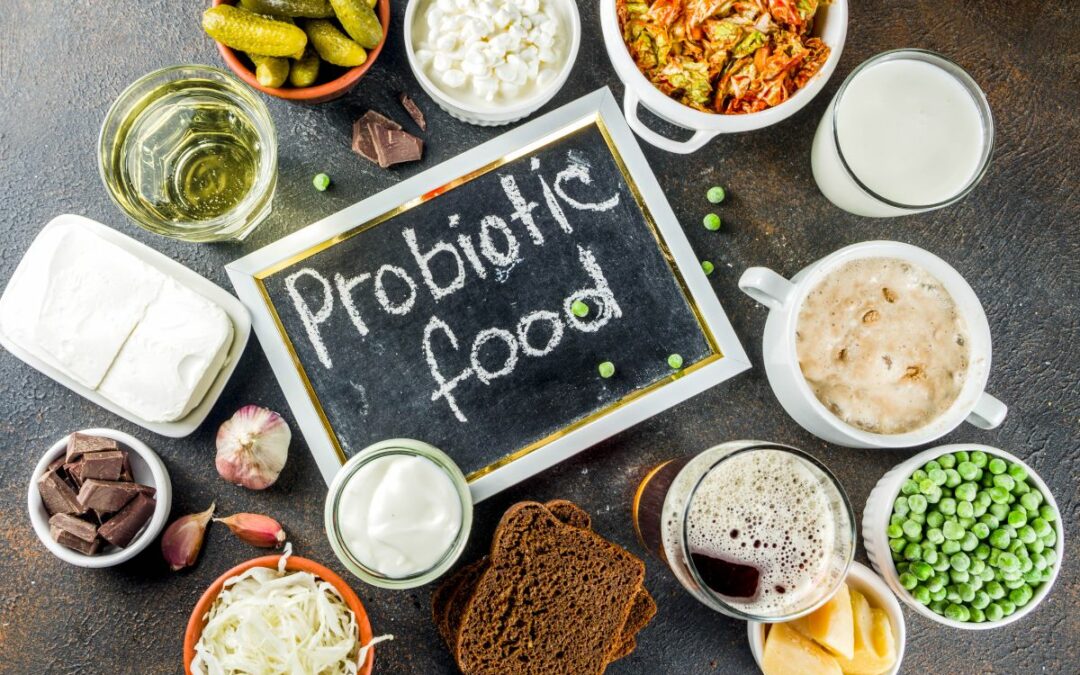If you want to improve your health and well-being, one of the best things you can do is to eat more probiotic foods and drinks. Probiotic foods and drinks contain live and beneficial microorganisms, such as bacteria and yeast, that can help balance your gut flora and support your digestive system. Probiotics can also boost your immune system, improve your mood, and prevent or treat various diseases.
But how do probiotics work? What are the benefits of probiotics for your brain and body? And what are the best probiotic foods and drinks to try?
In this blog post, we’ll answer these questions and more. We’ll also provide you with a list of 20 delicious and nutritious probiotic foods and drinks that you can easily incorporate into your diet. Let’s get started!
What Are Probiotics and How Do They Help Your Gut?
Your gut is home to trillions of microorganisms, such as bacteria, fungi, viruses, and other microbes, that make up your microbiome. These microbes play a vital role in your health, as they help digest your food, produce vitamins and hormones, regulate your metabolism, and protect you from harmful pathogens.
However, sometimes your gut flora can get out of balance due to factors such as stress, antibiotics, poor diet, illness, or aging. This can lead to digestive issues, inflammation, allergies, infections, and chronic diseases. That’s where probiotics come in.
Probiotics are live microorganisms that can restore and maintain a healthy balance of your gut flora. They do this by:
- Competing with harmful microbes for space and resources in your gut
- Producing substances that inhibit or kill harmful microbes
- Enhancing the function and integrity of your intestinal lining
- Modulating your immune system and reducing inflammation
- Communicating with your brain and influencing your mood and behavior
By doing these things, probiotics can improve your digestion, absorption, and elimination of food. They can also prevent or treat conditions such as diarrhea, constipation, irritable bowel syndrome, inflammatory bowel disease, ulcerative colitis, Crohn’s disease, and more.
How Probiotics Can Boost Your Mood, Immunity, and More
But probiotics are not only good for your gut. They can also benefit your brain and body in many ways. Here are some of the benefits of probiotics that have been supported by scientific research:
- Mental health: Probiotics can improve your mood, cognition, memory, and learning. They can also help prevent or treat depression, anxiety, autism, ADHD, and other neurological disorders. This is because your gut and brain are connected by the gut-brain axis, a complex network of nerves, hormones, and chemicals that allows them to communicate and influence each other. Probiotics can modulate this communication and affect your brain function and behavior.
- Immune system: Probiotics can strengthen your immune system and help you fight off infections and diseases. They can also reduce the severity and duration of common colds, flu, and respiratory infections. Probiotics can also prevent or treat allergies, asthma, eczema, and other immune-related disorders. This is because probiotics can regulate your immune system and reduce inflammation, which is the root cause of many diseases.
- Weight management: Probiotics can help you lose weight, maintain a healthy weight, or prevent obesity. They can do this by influencing your appetite, metabolism, and energy expenditure. Probiotics can also affect your hormones and genes that are involved in fat storage and burning. Probiotics can also prevent or treat metabolic syndrome, diabetes, and fatty liver disease, which are associated with obesity and insulin resistance.
- Heart health: Probiotics can improve your heart health and lower your risk of cardiovascular diseases. They can do this by lowering your blood pressure, cholesterol, and triglycerides. Probiotics can also prevent or treat atherosclerosis, which is the buildup of plaque in your arteries that can lead to heart attacks and strokes.
- Skin health: Probiotics can improve your skin health and appearance. They can do this by enhancing your skin barrier function, hydration, and elasticity. Probiotics can also prevent or treat acne, rosacea, dermatitis, psoriasis, and other skin conditions. This is because probiotics can affect your skin microbiome, which is the collection of microbes that live on your skin and influence its health and function.
As you can see, probiotics can benefit your health in many ways. But how can you get more probiotics in your diet? The answer is by eating probiotic foods and drinks.
20 Probiotic Foods and Drinks You Should Try Today
Probiotic foods and drinks contain live and active cultures of beneficial bacteria or yeast. They are usually made by fermenting milk, grains, fruits, vegetables, or other foods with specific strains of microbes. Fermentation is a natural process that preserves food, enhances its flavor, and adds probiotics to it.
There are many types of probiotic foods and drinks that you can choose from. Some of them are more common and widely available, while others are more exotic and rare.
Here are 20 of the best probiotic foods and drinks that you can try, ordered by their popularity and health benefits.
1. Yogurt
Yogurt is one of the most popular and widely consumed probiotic foods in the world. It is a fermented milk product that is made by adding specific strains of bacteria, usually lactobacilli and streptococci, to milk. Yogurt has a thick, creamy, and slightly sour taste. It is rich in protein, calcium, potassium, magnesium, and vitamin B12. It also contains a good amount of probiotics, especially if it is labeled as “live and active cultures”. Yogurt can improve your digestion, immunity, bone health, and weight management. It can also prevent or treat lactose intolerance, vaginal infections, and diarrhea.
You can eat yogurt plain or flavored, or use it in salads, dips, dressings, or desserts. You can also drink yogurt drinks, which are thinner and more liquid than yogurt. You can also make your own yogurt at home by heating milk, adding a starter culture, and letting it ferment in a warm place.
2. Kefir
Kefir is a fermented milk drink that originated in the Caucasus region. It is made by adding kefir grains, which are clusters of bacteria and yeast, to cow’s milk, goat’s milk, or plant-based milk. Kefir has a tangy, sour, and slightly carbonated taste. It is similar to yogurt, but thinner and more drinkable. It is rich in protein, calcium, phosphorus, vitamin B12, and riboflavin. It also contains a diverse and high amount of probiotics, including lactobacilli, bifidobacteria, streptococci, and yeasts. Kefir can improve your digestion, immunity, bone health, and mental health. It can also prevent or treat lactose intolerance, as the bacteria in kefir can break down lactose, the sugar in milk.
You can drink kefir plain or flavored, or use it in smoothies, soups, sauces, or baked goods. You can also make your own kefir at home by buying kefir grains online or from a health food store and following the instructions.
3. Sauerkraut
Sauerkraut is a fermented cabbage dish that originated in Germany. It is made by shredding and salting cabbage, and letting it ferment in a jar or a crock. Sauerkraut has a crunchy, sour, and salty taste. It is often eaten as a side dish or a topping, or used in soups, sandwiches, or casseroles. It is rich in fiber, vitamin C, vitamin K, and iron. It also contains a high amount of probiotics, mainly lactobacilli. Sauerkraut can improve your digestion, immunity, and metabolism. It can also prevent or treat scurvy, anemia, and ulcers.
You can eat sauerkraut plain or flavored, or use it in various recipes. You can also make your own sauerkraut at home by following the instructions.
4. Kimchi
Kimchi is a spicy fermented vegetable dish that originated in Korea. It is made by salting and seasoning cabbage, radish, cucumber, or other vegetables with garlic, ginger, chili, and other spices, and letting them ferment in a jar or a pot. Kimchi has a crunchy, sour, and spicy taste. It is often eaten as a side dish or a condiment, or used in soups, stews, or fried rice. It is rich in fiber, vitamin C, vitamin K, and iron. It also contains a high amount of probiotics, mainly lactobacilli. Kimchi can improve your digestion, immunity, and metabolism. It can also prevent or treat high blood pressure, high cholesterol, and cancer.
You can eat kimchi plain or flavored, or use it in various recipes. You can also make your own kimchi at home by following the instructions.
5. Miso
Miso is a fermented soybean paste that originated in Japan. It is made by mixing soybeans, rice, barley, or other grains with salt and a fungus called koji, and letting it ferment in a wooden barrel or a plastic container. Miso has a salty, savory, and umami taste. It is often used as a seasoning, a soup base, or a condiment.
Miso is rich in protein, iron, copper, and manganese. It also contains a high amount of probiotics, mainly lactobacilli and bifidobacteria. Miso can improve your digestion, immunity, and metabolism. It can also prevent or treat high blood pressure, high cholesterol, and cancer.
You can use miso in soups, sauces, dressings, or marinades. You can also make your own miso at home by using soybeans, rice, salt, and koji.
6. Tempeh
Tempeh is a fermented soybean cake that originated in Indonesia. It is made by cooking and dehulling soybeans, inoculating them with a fungus called Rhizopus, and forming them into a firm and dense cake. Tempeh has a nutty, earthy, and slightly bitter taste. It is often used as a meat substitute or a protein source in vegetarian and vegan dishes.
Tempeh is rich in protein, iron, calcium, and magnesium. It also contains a moderate amount of probiotics, mainly Rhizopus and other molds. Tempeh can improve your digestion, immunity, and cholesterol levels. It can also prevent or treat anemia, osteoporosis, and diabetes.
You can eat tempeh plain or flavored, or use it in salads, sandwiches, burgers, or stir-fries. You can also make your own tempeh at home by using soybeans, vinegar, and tempeh starter.
7. Kombucha
Kombucha is a fermented tea drink that originated in China. It is made by adding a symbiotic culture of bacteria and yeast, also known as SCOBY, to sweetened black or green tea, and letting it ferment in a jar or a bottle. Kombucha has a fizzy, sour, and slightly sweet taste. It is often flavored with fruits, herbs, or spices.
Kombucha is rich in antioxidants, polyphenols, and organic acids. It also contains a moderate amount of probiotics, mainly acetic acid bacteria and yeasts. Kombucha can improve your digestion, immunity, and liver health. It can also prevent or treat oxidative stress, inflammation, and infections.
You can drink kombucha plain or flavored, or use it in cocktails, mocktails, or smoothies. You can also make your own kombucha at home by buying a SCOBY online or from a health food store and following the instructions.
8. Pickles
Pickles are fermented cucumbers or other vegetables that are made by soaking them in brine, vinegar, or other solutions. Pickles have a crunchy, sour, and salty taste. They are often eaten as a snack or a garnish, or used in salads, sandwiches, or burgers.
Pickles are rich in fiber, vitamin K, and sodium. They also contain some probiotics, mainly lactobacilli, if they are made with brine and not vinegar. Pickles can improve your digestion, immunity, and blood sugar levels. They can also prevent or treat muscle cramps, dehydration, and scurvy.
You can eat pickles plain or flavored, or use them in various recipes. You can also make your own pickles at home by using cucumbers, salt, water, and spices.
9. Traditional Buttermilk
Traditional buttermilk is a fermented milk drink that is made by churning butter from cream and collecting the leftover liquid. Traditional buttermilk has a thin, creamy, and slightly sour taste. It is often used in baking, cooking, or drinking.
Traditional buttermilk is rich in protein, calcium, phosphorus, and riboflavin. It also contains a good amount of probiotics, mainly lactobacilli. Traditional buttermilk can improve your digestion, immunity, and bone health. It can also prevent or treat lactose intolerance and diarrhea.
You can drink traditional buttermilk plain or flavored, or use it in pancakes, biscuits, cakes, or soups. You can also make your own traditional buttermilk at home by using cream, butter, and a starter culture.
10. Sourdough Bread
Sourdough bread is a type of bread that is made by fermenting dough with a mixture of flour and water, also known as a starter or a leaven. Sourdough bread has a chewy, crusty, and slightly sour taste. It is often used for making toast, sandwiches, or pizza.
Sourdough bread is rich in carbohydrates, fiber, and iron. It also contains some probiotics, mainly lactobacilli and yeasts, if it is made with a natural starter and not commercial yeast. Sourdough bread can improve your digestion, immunity, and blood sugar levels. It can also prevent or treat gluten intolerance and candida.
You can eat sourdough bread plain or flavored, or use it in various recipes. You can also make your own sourdough bread at home by using flour, water, and a starter.
11. Natto
Natto is a fermented soybean dish that originated in Japan. It is made by cooking and fermenting soybeans with a bacterium called Bacillus subtilis. Natto has a sticky, slimy, and stringy texture, and a pungent, nutty, and cheesy taste. It is often eaten as a breakfast food, or used in sushi, rice, or noodles.
Natto is rich in protein, iron, vitamin K, and nattokinase. It also contains a high amount of probiotics, mainly Bacillus subtilis. Natto can improve your digestion, immunity, and blood clotting. It can also prevent or treat osteoporosis, cardiovascular diseases, and cancer.
You can eat natto plain or flavored, or use it in various recipes. You can also make your own natto at home by using soybeans and natto starter.
12. Gouda Cheese
Gouda cheese is a type of cheese that originated in the Netherlands. It is made by curdling and pressing milk, and aging it for different periods of time. Gouda cheese has a smooth, creamy, and nutty taste. It is often used for making cheese boards, sandwiches, or fondue.
Gouda cheese is rich in protein, calcium, phosphorus, and vitamin B12. It also contains some probiotics, mainly lactobacilli and propionibacteria, if it is aged and made from raw or unpasteurized milk. Gouda cheese can improve your digestion, immunity, and bone health. It can also prevent or treat lactose intolerance and cavities.
You can eat gouda cheese plain or flavored, or use it in various recipes. You can also make your own gouda cheese at home by using milk, rennet, and starter cultures.
13. Kvass
Kvass is a fermented beverage that originated in Eastern Europe. It is made by fermenting rye bread, barley, wheat, or other grains with water, sugar, and yeast. Kvass has a malty, sour, and slightly carbonated taste. It is often flavored with fruits, herbs, or spices.
Kvass is rich in B vitamins, minerals, and enzymes. It also contains a good amount of probiotics, mainly lactobacilli and yeasts. Kvass can improve your digestion, immunity, and blood health. It can also prevent or treat anemia, fatigue, and scurvy.
You can drink kvass plain or flavored, or use it in soups, salads, or cocktails. You can also make your own kvass at home by using bread, water, sugar, and yeast.
14. Apple Cider Vinegar
Apple cider vinegar is a fermented apple juice that is made by adding yeast and bacteria to apple juice, and letting it ferment in a jar or a bottle. Apple cider vinegar has a tart, acidic, and fruity taste. It is often used as a salad dressing, a marinade, or a health tonic.
Apple cider vinegar is rich in acetic acid, malic acid, and antioxidants. It also contains some probiotics, mainly acetic acid bacteria, if it is raw, organic, and unfiltered. Apple cider vinegar can improve your digestion, immunity, and metabolism. It can also prevent or treat high blood sugar, high cholesterol, and infections.
You can drink apple cider vinegar plain or diluted, or use it in various recipes. You can also make your own apple cider vinegar at home by using apple juice, sugar, and a starter culture.
15. Olives
Olives are the fruits of the olive tree that are native to the Mediterranean region. They are usually cured and fermented in brine, oil, or vinegar, to make them edible and tasty. Olives have a soft, chewy, and salty taste. They are often eaten as a snack or a garnish, or used in salads, pizzas, or pasta.
Olives are rich in healthy fats, vitamin E, and antioxidants. They also contain some probiotics, mainly lactobacilli, if they are cured and fermented in brine and not vinegar. Olives can improve your digestion, immunity, and heart health. They can also prevent or treat inflammation, arthritis, and cancer.
You can eat olives plain or flavored, or use them in various recipes. You can also make your own olives at home by using fresh olives, salt, water, and spices.
16. Traditional Soy Sauce
Traditional soy sauce is a fermented soybean sauce that originated in China. It is made by fermenting soybeans, wheat, salt, and water with a fungus called Aspergillus, and aging it for several months or years. Traditional soy sauce has a dark, salty, and savory taste. It is often used as a seasoning, a dip, or a condiment.
Traditional soy sauce is rich in protein, amino acids, and antioxidants. It also contains some probiotics, mainly lactobacilli and yeasts, if it is naturally brewed and not chemically processed. Traditional soy sauce can improve your digestion, immunity, and metabolism. It can also prevent or treat high blood pressure, high cholesterol, and allergies.
You can use traditional soy sauce in soups, sauces, stir-fries, or sushi. You can also make your own traditional soy sauce at home by using soybeans, wheat, salt, water, and koji.
17. Brine-Cured Olives
Brine-cured olives are a type of olives that are cured and fermented in brine, which is a solution of water and salt. Brine-cured olives have a soft, chewy, and salty taste. They are often eaten as a snack or a garnish, or used in salads, pizzas, or pasta.
Brine-cured olives are rich in healthy fats, vitamin E, and antioxidants. They also contain a good amount of probiotics, mainly lactobacilli, as they are cured and fermented in brine. Brine-cured olives can improve your digestion, immunity, and heart health. They can also prevent or treat inflammation, arthritis, and cancer.
You can eat brine-cured olives plain or flavored, or use them in various recipes. You can also make your own brine-cured olives at home by using fresh olives, salt, water, and spices.
18. Cottage Cheese
Cottage cheese is a fresh cheese that is made by curdling milk and draining the whey. It has a mild, milky, and slightly tangy taste. It is usually eaten as a snack or breakfast food, or used in salads, sandwiches, or casseroles.
Cottage cheese is rich in protein, calcium, phosphorus, and selenium. It also contains some probiotics, especially if it is labeled as “cultured” or “with live and active cultures”. Cultured cottage cheese can improve your digestion, immunity, and muscle health. It can also prevent or treat lactose intolerance and constipation.
You can eat cultured cottage cheese plain or flavored, or use it in various recipes. You can also make your own cultured cottage cheese at home by adding a starter culture to milk and letting it ferment in a warm place.
19. Fermented Salsa
Fermented salsa is a spicy fermented tomato sauce that originated in Mexico. It is made by blending tomatoes, onions, garlic, peppers, cilantro, and salt, and letting it ferment in a jar or a bowl. Fermented salsa has a chunky, sour, and spicy taste. It is often used as a dip, a topping, or a condiment.
Fermented salsa is rich in lycopene, vitamin C, and antioxidants. It also contains a moderate amount of probiotics, mainly lactobacilli. Fermented salsa can improve your digestion, immunity, and metabolism. It can also prevent or treat infections, ulcers, and cancer.
You can eat fermented salsa plain or flavored, or use it in various recipes. You can also make your own fermented salsa at home by using fresh ingredients and following the instructions.
20. Raw Milk Cheese
Raw milk cheese is a type of cheese that is made from raw or unpasteurized milk. Raw milk cheese has a more complex, intense, and varied taste than pasteurized milk cheese. It is often used for making cheese boards, sandwiches, or fondue.
Raw milk cheese is rich in protein, calcium, phosphorus, and vitamin B12. It also contains a high amount of probiotics, mainly lactobacilli and propionibacteria, as it is made from raw milk and aged for a long time. Raw milk cheese can improve your digestion, immunity, and bone health. It can also prevent or treat lactose intolerance and cavities.
You can eat raw milk cheese plain or flavored, or use it in various recipes. You can also make your own raw milk cheese at home by using raw milk, rennet, and starter cultures.
Practical Ways to Include Probiotic Foods and Drinks in Your Diet
Now that you know the best probiotic foods and drinks to try, you might be wondering how to incorporate them into your diet. Here are some tips and suggestions to help you do that:
- Kickstart your morning with a probiotics: You can start your day with a probiotic boost by having a glass of kefir, a bowl of yogurt, or a slice of sourdough bread for breakfast. You can also add some fruits, nuts, seeds, or granola to your probiotic foods for extra flavor and nutrition.
- Try adding fermented foods to your recipes: You can experiment with fermented foods in your recipes by using them as ingredients, seasonings, or toppings. For example, you can use miso, natto, or soy sauce to add flavor and umami to your soups, sauces, or stir-fries. You can use kimchi, sauerkraut, or pickles to add crunch and tang to your salads, sandwiches, or burgers. You can use cheese, labneh, or cottage cheese to add creaminess and richness to your pizzas, pastas, or casseroles. You can use kombucha, kvass, or tepache to add fizz and freshness to your cocktails, mocktails, or smoothies. The possibilities are endless!
- Enjoy prebiotics and probiotics together: You can pair probiotics with prebiotics to enhance their effects and benefits. Prebiotics are types of fiber that feed the probiotics and help them grow and thrive in your gut. Some of the best sources of prebiotics are fruits, vegetables, grains, nuts, seeds, and legumes. For example, you can pair yogurt with bananas, oats, or almonds. You can pair kefir with berries, flaxseeds, or walnuts. You can pair sauerkraut with potatoes, carrots, or peas. You can pair cheese with apples, pears, or whole wheat bread. You can pair miso with rice, broccoli, or beans. By combining probiotics and prebiotics, you can create a symbiotic relationship that can boost your gut health and overall well-being.
- Try probiotic supplements: You can consider probiotic supplements if you want to get more probiotics in your diet, or if you have a specific health condition that requires a higher dose or a specific strain of probiotics. Probiotic supplements are capsules, tablets, powders, or liquids that contain concentrated and standardized amounts of probiotics. They are usually sold in health food stores, pharmacies, or online. Probiotic supplements can improve your digestion, immunity, and other aspects of your health. They can also prevent or treat various diseases, such as irritable bowel syndrome, ulcerative colitis, Crohn’s disease, and more. However, before you take any probiotic supplements, you should consult your doctor, as they may have side effects or interactions with other medications or supplements that you are taking.
- Enjoy probiotic foods and drinks in moderation: You can enjoy probiotic foods and drinks in moderation, as they are generally safe and beneficial for most people. However, you should not overdo it with probiotic foods and drinks, as they may have some drawbacks or risks if you consume too much of them. For example, some probiotic foods and drinks may contain high amounts of salt, sugar, calories, or additives, which may not be good for your health. Some probiotic foods and drinks may also cause bloating, gas, diarrhea, or allergic reactions in some people, especially if they are new to them or have a sensitive gut. Therefore, you should start with small amounts of probiotic foods and drinks, and gradually increase your intake as your body adjusts to them. You should also listen to your body and stop eating or drinking probiotic foods and drinks if you experience any discomfort or adverse effects.
That’s it for the tips and suggestions on how to incorporate probiotic foods and drinks into your diet. I hope you found them helpful and informative. Now you know the best probiotic foods and drinks to try, and how to enjoy them in a healthy and balanced way. Probiotic foods and drinks can fuel your healthy, happy gut, and improve your overall well-being. So, what are you waiting for? Go ahead and try some probiotic foods and drinks today, and see the difference they can make for your health! 😊









